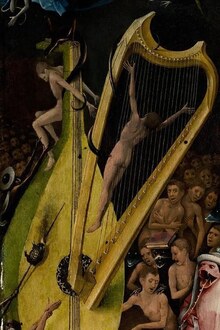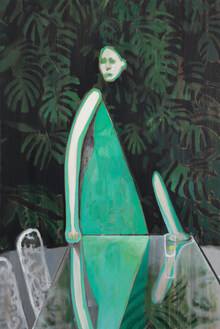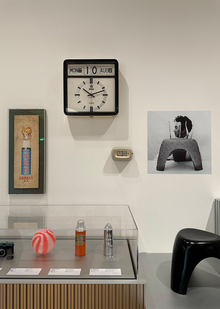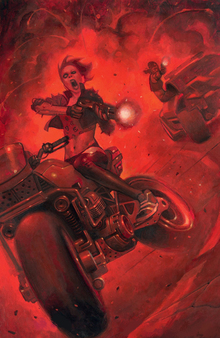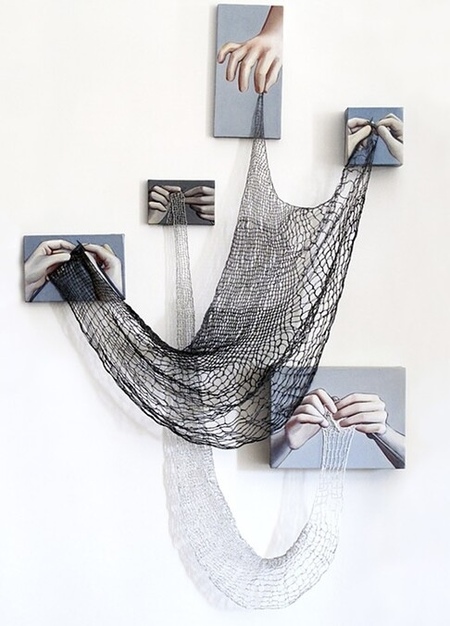
contemporary artists from the Middle East
The Middle East has a rich and diverse contemporary art scene, with many talented artists contributing to the region’s cultural landscape. Here are 50 contemporary artists from the Middle East and North Africa:
1. Dana Awartani (Saudi Arabia, b. 1987) Known for her abstract sculptures that blend traditional Islamic geometries with contemporary practice. Example: Icosahedron within a Dodecahedron (2016), sold for $35,280 at Christie’s Online.
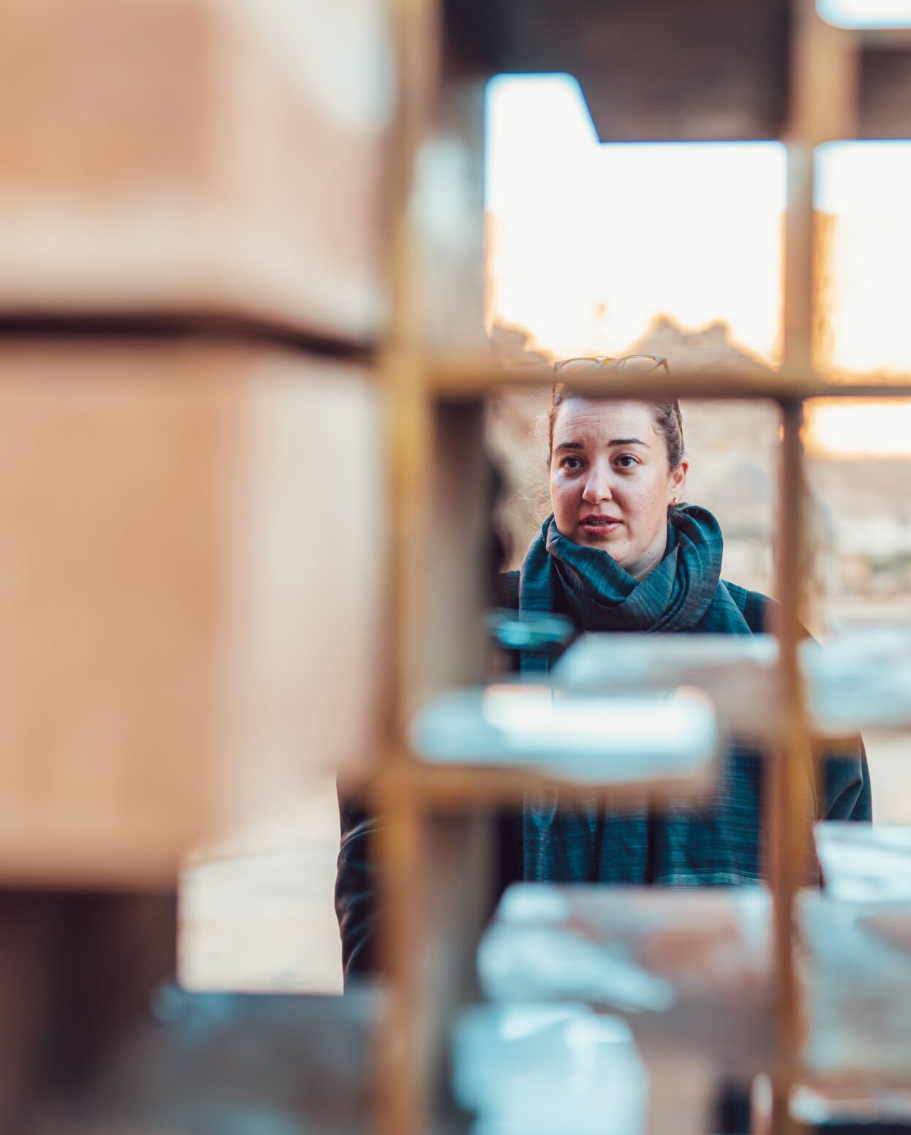
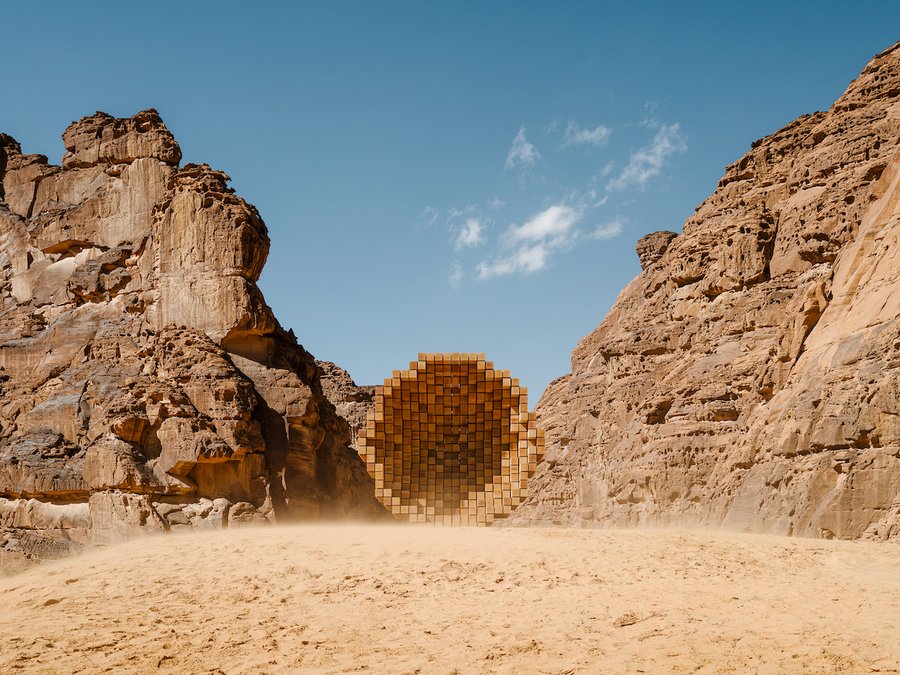
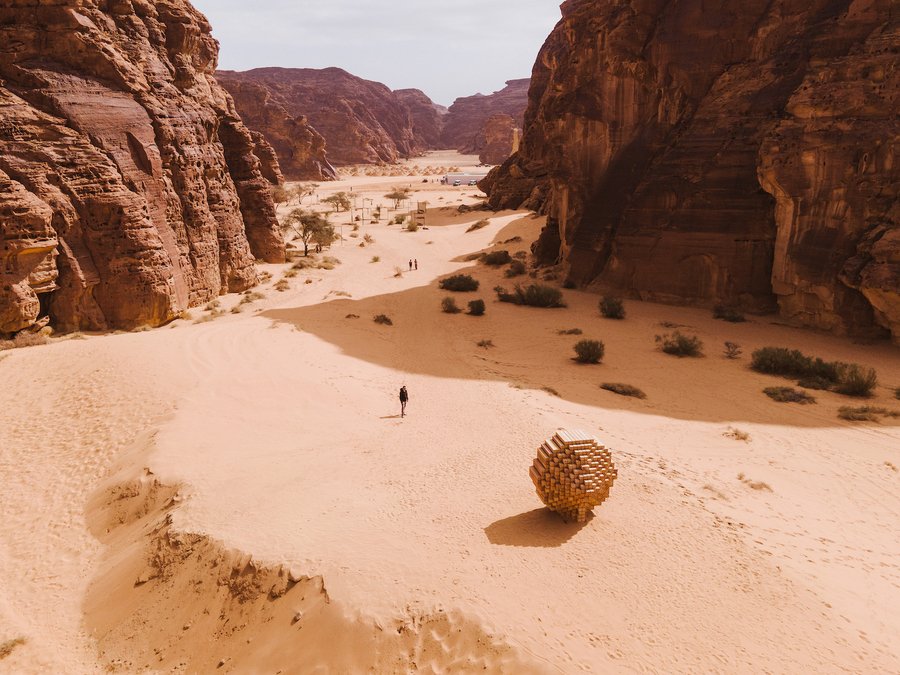
Where the Dwellers Lay, 2022, Sandstone and Oxidised Steel, 315 cm x 315 cm x 223 cm. Image courtesy of Lance Gerber and the Royal Commission for AlUla.
Dana Awartani (b. 1987) is a Saudi-Palestinian artist, living and working in Jeddah. Her oeuvre aspires for the revival of traditional geometry and historical modes of making through crafts and artisanal practices which are enacted in the contemporary. Traditionally trained at the Prince’s School of Traditional Arts, she received her Master’s after her BA and Foundation degrees at Central Saint Martins. She is currently furthering her practice and commitment to preservation of the Islamic illumination skills through the completion of an ‘Ijaza’ certificate, in order to be eligible to transmit these skills.
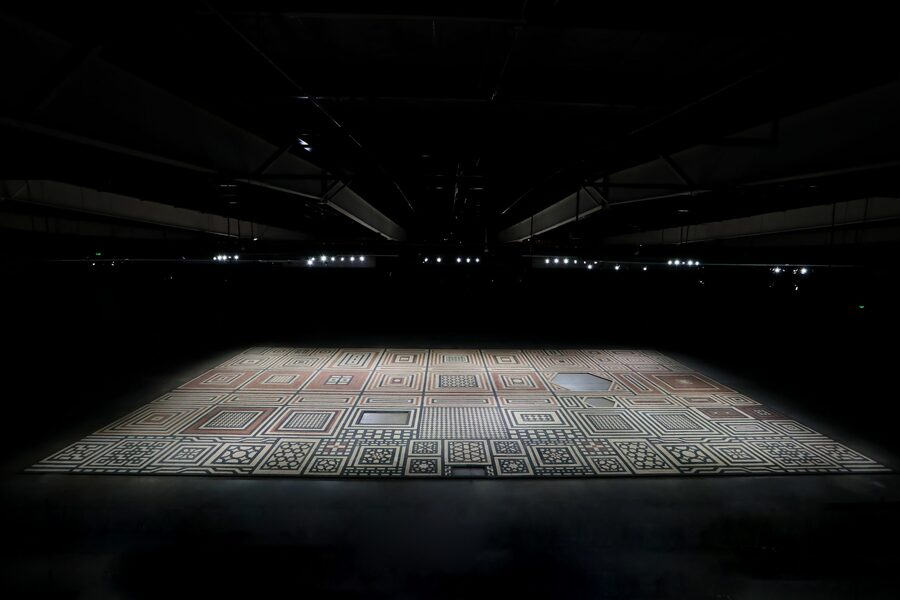
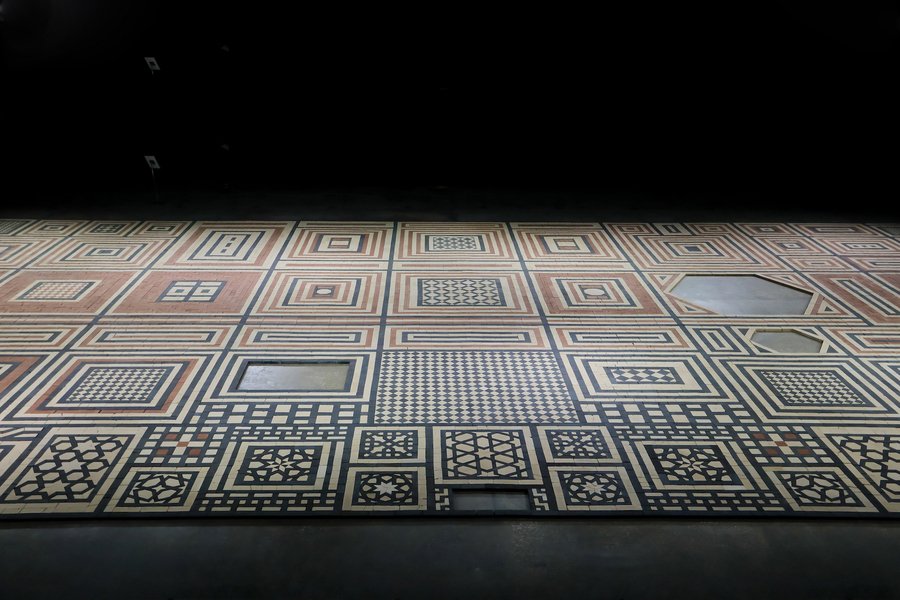
Standing by the Ruins of Aleppo, 2021, Clay Earth, 2277×1300 cm. Image courtesy of the Dariyah Biennale Foundation and Canvas.
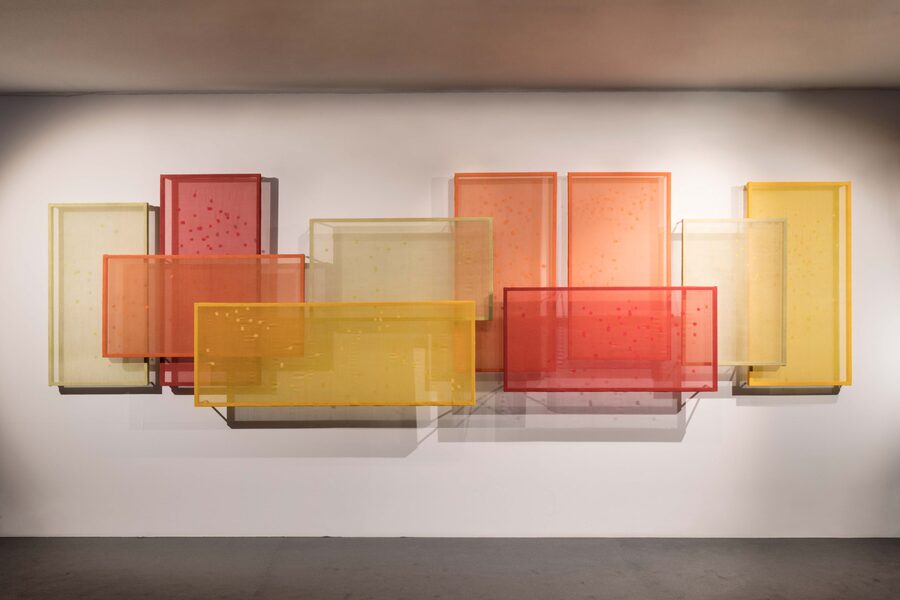
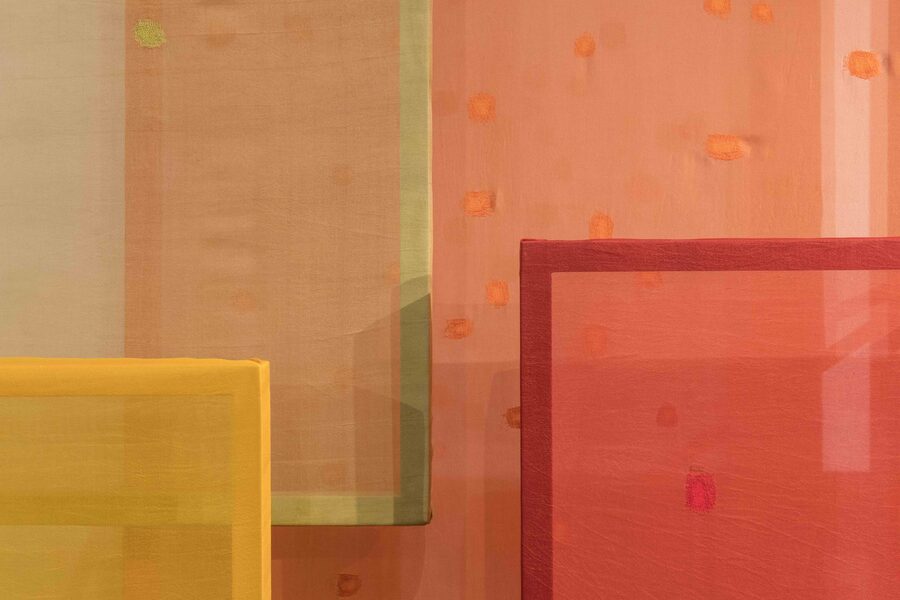
Detail from Come, let me heal your wounds. Let me mend your broken bones, as we stand here mourning, 2020, Darning on medicinally dyed silk, 480 cm x 136 cm x 10 cm. Image courtesy of Thyssen-Bornemis
Her work has been part of numerous group shows at institutions around the world. She participated in the Lyon Biennale, Lyon, France (2022), the Diriyah Biennale, Riyadh, Saudi Arabia (2021), Rabat Biennale, Morocco (2019), Sesc_Videobrasil Biennale, Sao Paulo, Brazil (2019), the Jakarta Biennale, Indonesia (2017), the Marrakech Biennale, Morocco (2016), the Yinchuan Biennale, China (2016), and the Kochi-Muziris Biennale, India (2016). Her solo exhibitions include: The Silence Between Us, Maraya Art Centre, Sharjah, UAE. (2018); Detroit Affinities: Dana Awartani, Museum of Contemporary Art Detroit, Detroit (2017); and The Hidden Qualities of Quantities, Athr, Jeddah (2015).
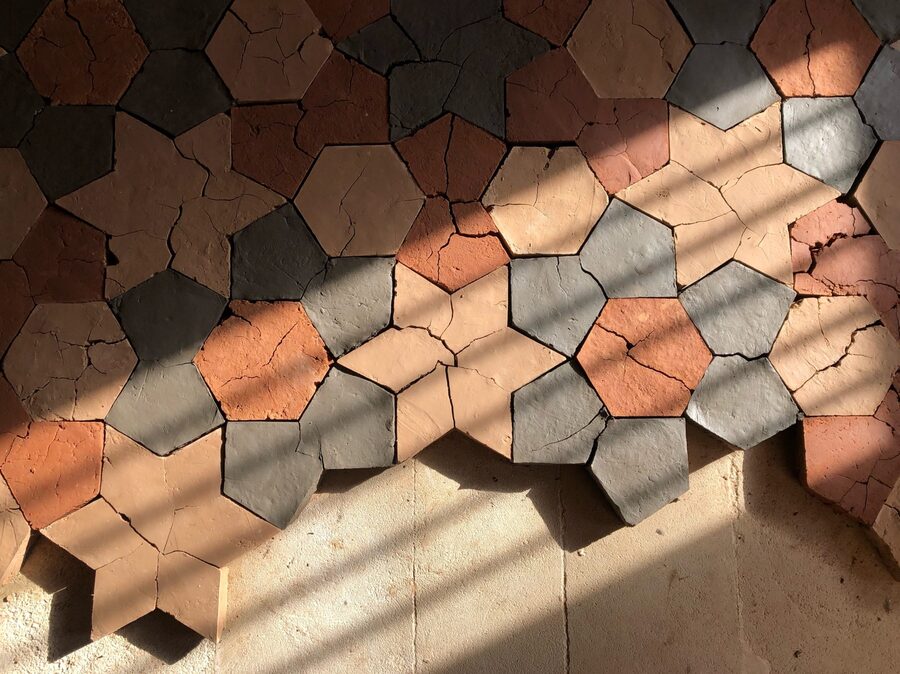
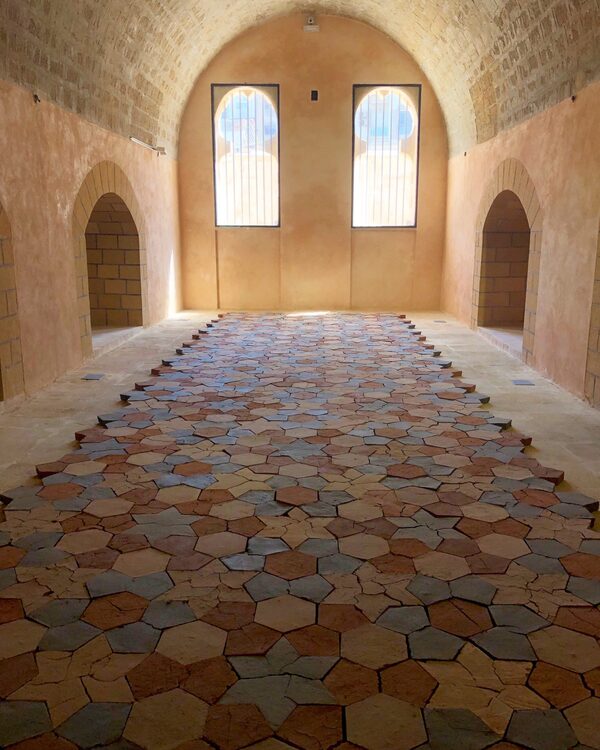
Installation shot of Standing by the Ruins at the Rabat Biennale 2019. Compressed earth, 450×1130 cm. Image courtesy of the Artist.
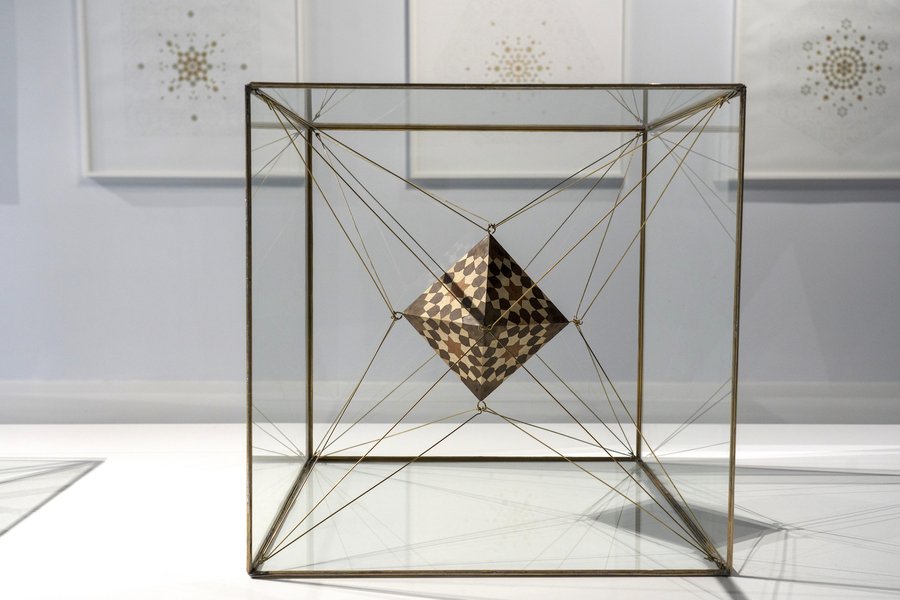
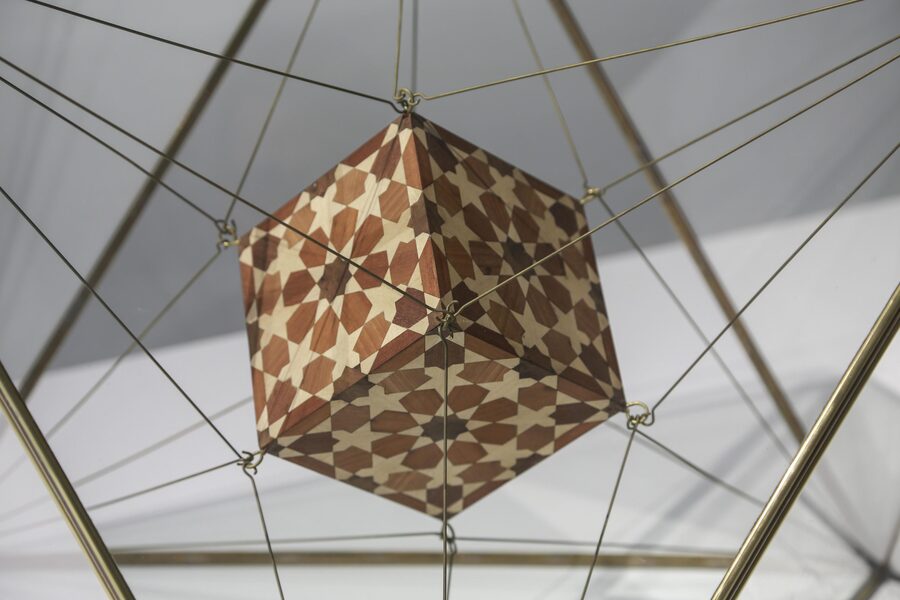
Installation shot of Octahedron Within a Cube II from The Platonic Solid Duals series, 2019, Wood, copper and brass, 121×100,2×100.2 cm. Image courtesy of Maraya Art Centre.
2. Nadia Kaabi-Linke (Tunisia, b. 1978) Explores themes of geopolitics, borders, and migration through her multimedia installations. Example: Carthage Presidence (2009), sold for $52,920 at Christie’s Online.
Nadia Kaabi-Linke | The Guggenheim Museums and Foundation Creator: Kristopher McKay
Flying Carpets, 2011
Kaabi-Linke was born in Tunis in 1978, and studied at the Academy of Fine Arts in Tunis, and later at the Sorbonne University in Paris. Recent solo exhibitions include A Matter of Resilience, Darat Al Funun, Amman, 2020; Impossible Ordinary, Lawrie Shabibi, Dubai, 2018-19; VersiegelteZeit [Sealed Time], Kunstmuseum, 2017-2018; Lost and Found, Experimenter, Kolkata, 2016; Walk the Line, Dallas Contemporary, Dallas; 2015; FAHRENHEIT311: Seven Legends of Machismo, Lawrie Shabibi, Dubai, 2015; No Frills, Cristina Guerra Contemporary Art, Lisbon, 2015; The Future Rewound and The Cabinet of Souls, The Mosaic Rooms, London; Stranded — Preso por fios, Centro de Arte Moderna da Fundação Calouste Gulbenkian, Lisbon 2014; No One Harms Me, Experimenter, Kolkata, 2013 and Black is the New White
STRETCHED PERM, 2014 52 offset prints with hair on paper 40.5×30 cm 16×11 ¾ in
ALTARPIECE, 2015 Silk paper, Wax, Chinese Ink (Encre de Chine), Acrylic (Lascaux), Varnish (Lascaux satin), Wood frame coated in 24 K gold leaf 250×450,4×6.3 cm 98 3/8×177 3/8×2 ½ in
Select group exhibitions include A Bottomless Silence, Wallach Art Gallery, Columbia University, 2020; Walking Through Walls, Gropius Bau, Berlin 2019; The Sensation of Space, The Warehouse, Dallas, 2019; How To See (What Isn’t There), Langen Foundation, Neuss, 2018; Body Ego, Dallas Museum of Art; Lahore Biennale, 2018; Inhabiting Territories, MOVIMENTA Biennale, Nice, 2017; Witness, Karachi Biennale, 2017; Borders of Visibility, 25th Slavonian Biennale, 2016; Songlines for a New Atlas, Kalmar konstmuseum, Sweden, 2016; Social Calligraphies: East ̶ West, Zachęta National Gallery of Art, Warsaw, 2016; Between Structure and Matter: Other Minimal Futures, Curated by Prajit Dutta and Murtaza Vali, Aicon Gallery, New York, 2016; But a Storm is Blowing from Paradise.
PARKVERBOT (KÖPENICK), 2017 Modified park bench from the Berlin District Kopenick Wood, cast iron, and steel 250×60×70 cm 98.4×23,6×27.5 in
JINS AL LATIF, 2018 Steel, plywood, acrylic 60×54 cm 23 5/8×21 ¼ in
3. Mohamed Ahmed Ibrahim (United Arab Emirates, b. 1962) Represented the UAE at the 59th Venice Biennale with his installation.
Courtesy the artist and Sharjah Art Foundation
Ibrahim came of age as an artist in the UAE in an era in which the visual arts were not yet valued culturally or taught in university degree programs. In 1986, when he met the late artist Hassan Sharif (a founding member of the influential Emirates Fine Art Society), Ibrahim was pulled out of a secluded practice and carved out unshakable friendships and collaborations that have formed the foundation for the creative community that defines the UAE today.
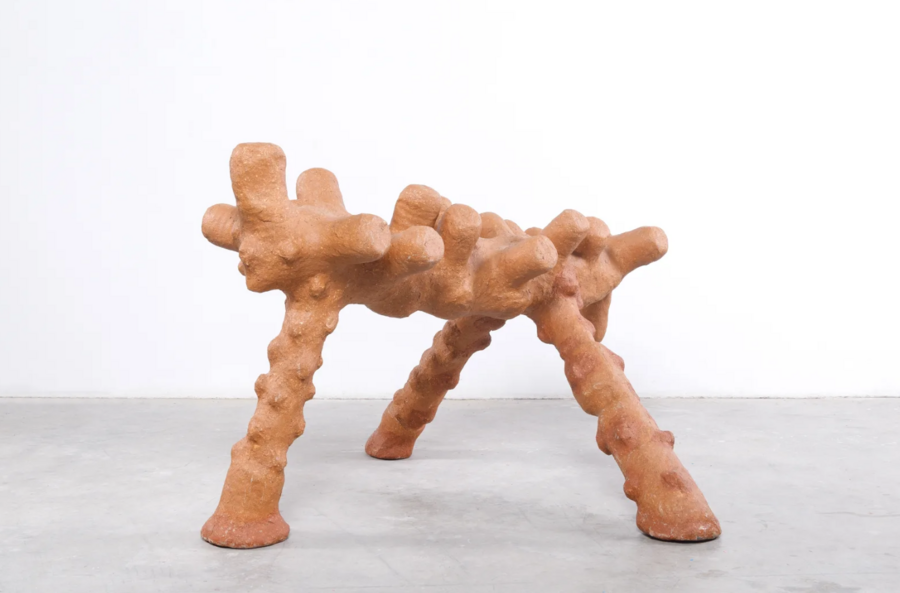
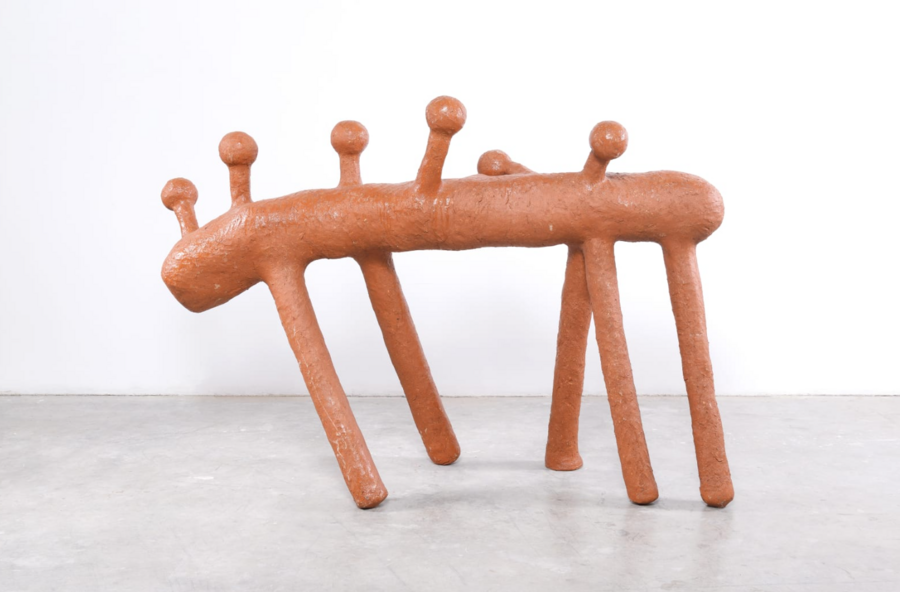
ANIMAL 1 & 2, 2014 Wood, paper, clay, glue 112×163×60 cm 44 1/8×64 1/8×23 5/8 in
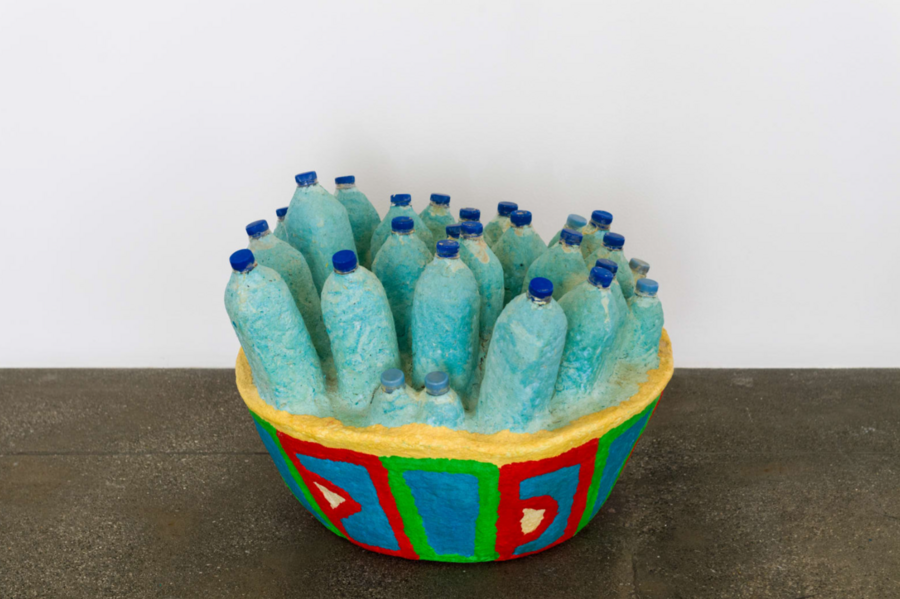
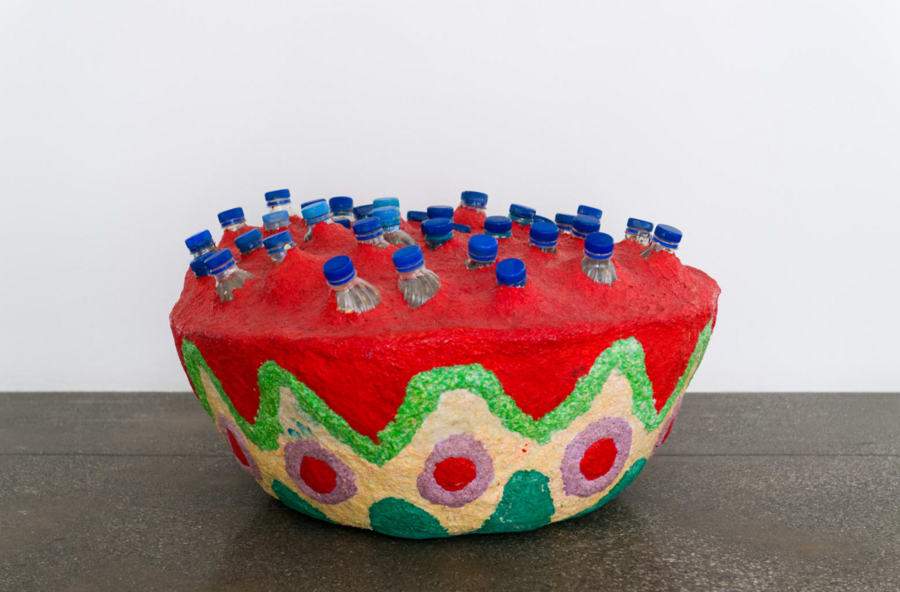
FRUIT BASKET, 2010 Plastic bottles, papier-mâché 35.5×66×64 cm 14×26×25 ¼ in
FRUITS, 2012 Plastic bottles, papier-mâché 130×35×35 cm 51 1/8×13 ¾×13 ¾ in Dimensions variable
GREEN APPLE TREE, 2013 TBC Plastic bottles, papier-mâché 140×50×50 cm 55 1/8×19 ¾×19 ¾ in Variable dimensions
LEMON TREE, 2013 Plastic bottles, papier-mâché 143×50×50 cm 56 ¼×19 ¾×19 ¾ in Variable dimensions
TOMATO TREE, 2013 TBC Plastic bottles, papier-mâché 180×65×67 cm 70 7/8×25 5/8×26 3/8 in Variable dimensions
Mohamed Ahmed Ibrahim represented the UAE at the 2022 Venice Biennale with a large-scale installation titled Mohamed Ahmed Ibrahim: Between Sunrise and Sunset. The exhibition presented a new body of work created for the National Pavilion UAE, curated by Maya Allison, Executive Director of The New York University Abu Dhabi Art Gallery.
In March 2018, Elements, a survey of works spanning three decades of his practice, was presented at the Sharjah Art Foundation, curated by Sheikha Hoor Al Qasimi.
Ibrahim’s recent solo exhibitions include Elevation at Abu Dhabi Art with Lawrie Shabibi (2023); The Armory Show with Lawrie Shabibi, New York (2022); Embryonic Coat, (2022), Memory Drum (2020) and The Space between the Eyelid and the Eyeball (2019) at Lawrie Shabibi, Dubai, as well as a seri
UNTITLED, 2015 Paper assemblage 31×30 cm 12 ¼×11 ¾ in
UNTITLED, 2016 Cardboard, tarp, twine, papier-mâché, acrylic 65×49×6 cm 25 5/8×19 ¼×2 3/8 in
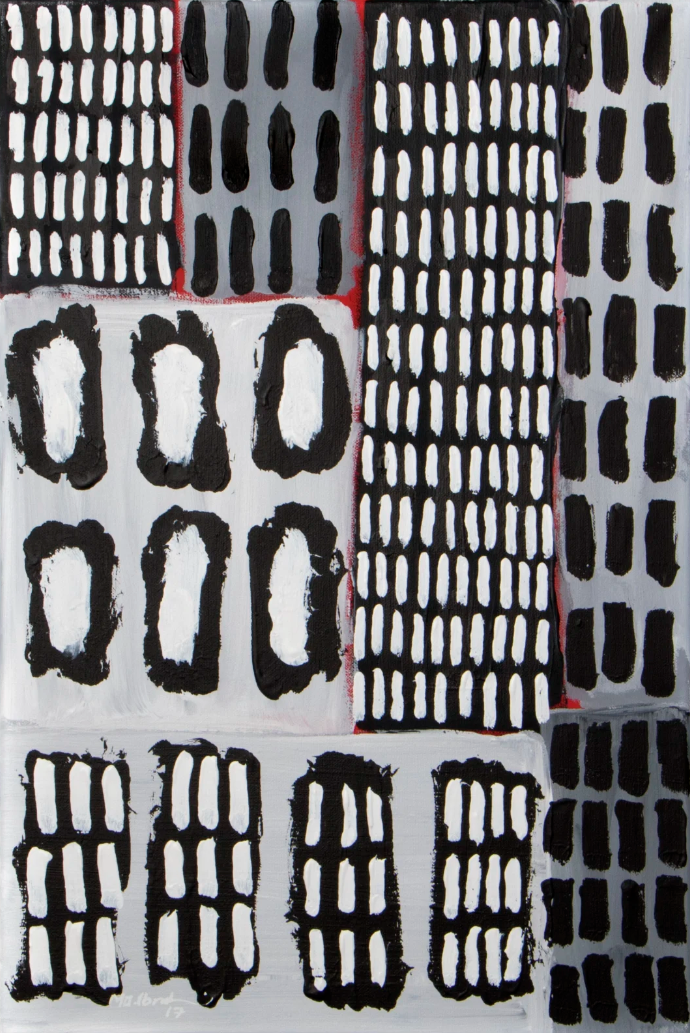
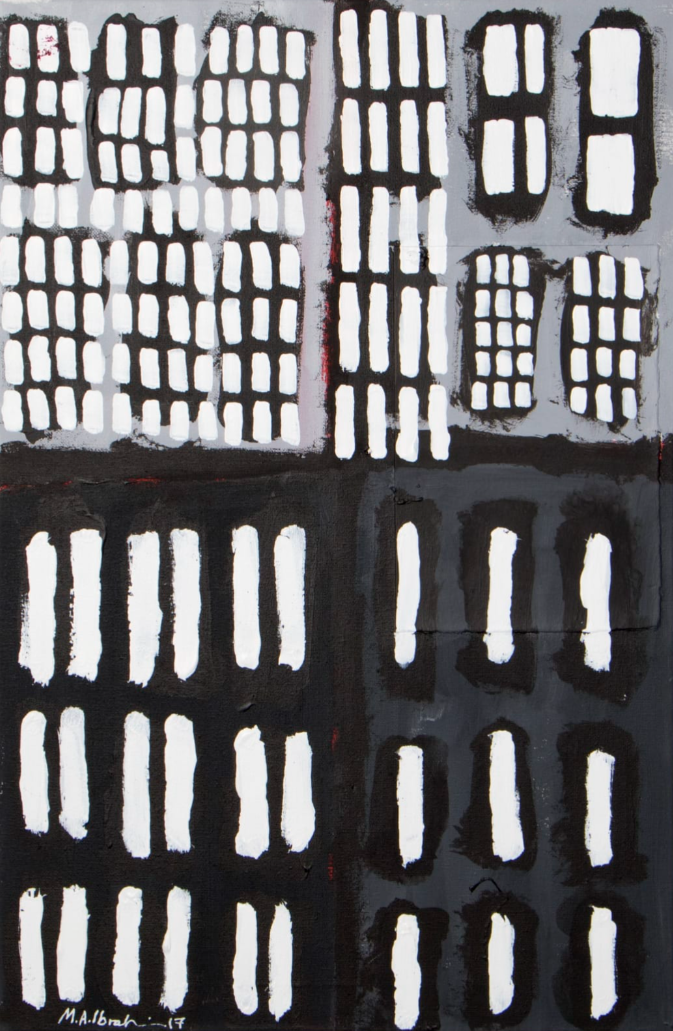
MIXED LINES, 2017 Acrylic on canvas 60×40×1.5 cm 23 5/8×15 ¾×5/8 in
4. Farhad Moshiri (Iran) Combines pop art elements to comment on the relationship between East and West. Example: His work is characterized by a blend of Western consumerism and Middle Eastern artifacts.
Farhad Moshiri increases stake in Everton to become club’s majority shareholder | The Independent
Saffron of Ghaenat, 2003
Flower Power, 2008
Shukran, 2011
Colored Knives on Black Presented by Perrotin Paintings 165×155×29 cm
Farhad Moshiri Living between Tehran and Paris, Farhad Moshiri has developed a personal language in which he discusses commonalities in Iranian and Western cultures. Inspired by Pop art, Moshiri overturns both pop culture and highbrow imagery by transforming it into figurative artwork. His pieces are made using everyday objects as well as luxurious materials such as pearls, crystals, sequins, and gold leaf. Although his practice appears as playful and decorative, Moshiri offers a critical narrative beyond the shimmering surfaces. He addresses the flaws of contemporary Iran all while toying with its traditional forms, and acknowledges the appeal of the Western world in addition to its limitations.
Frieze New York, 2012
Train Catcher, 2017
First Snow 1D, 2018
Today, 2018
As long as you are, I am, 2023 Oil, tempera, acrylic, gold-leaf and glue on canvas 215×176 cm
5. Samia Halaby (Palestine) A leading figure in Palestinian art, known for her abstract paintings and activism. Example: Her work has been shown in institutions such as The British Museum and the Guggenheim.
Palestinian Artist Samia Halaby has Some Thoughts on Politics and She’s not Afraid to Show It September 14, 2018 Nadia Michel
Samia Halaby is hard to pin down. She’s an advocate for fellow Palestinian artists, but says her own art isn’t about Palestine; she works in bold abstractions, yet describes medieval art as an influence. Her work has been often overlooked — but now she’s finally getting a celebratory retrospective in the form of a new book, Samia Halaby: Five Decades of Painting and Innovation, out this March.
Left: The Red One, 2018 (122×152.5 cm) / Right: Light in Darkness, 2015 (178 cm x 178 cm)
The Apron After Gorky’s Mother, 1963 Photo: Samia Halaby
Blue Window Sphere Retouch, 1966 Photo: Samia Halaby
A Rose, 1987 Photo: Samia Halaby
Dance on Canal, 1995 Photo: Samia Halaby
Born in Jerusalem in 1936, Halaby was 12 when her family was driven out of their home in Jaffa. Her family sought refuge in Lebanon, and then Cincinnati; after pursuing her MFA at Indiana University in Bloomington, Halaby became the first full-time female professor at the Yale School of Art. Halaby taught there for ten years until 1982, when, despite having promised her a permanent position, Yale failed to renew her contract — a move which Halaby believes had to do with her gender and her increasing political activism. She decamped for New York. «Now there are a few Palestinians in galleries, ” Halaby told the Cut when we spoke in her Tribeca loft. „But in those days, being female and then, on top of that, being Palestinian, made things extremely difficult.“
Big One For Bethlehem, 2003 Photo: Samia Halaby Expand Photo
Demolish The Wall Let Life Be Fertile, 2004 Photo: Samia Halaby
6. Rania Hassan (Egypt) Explores themes of identity, culture, and politics through her multimedia installations. Example: Her work often incorporates traditional Egyptian motifs and symbolism.
Rania Hassan combines knitting and painting to weave sculptural stories about our connections to time, place, and circumstance.
artist statement We all seek connection, whether it’s how we connect to each other, people who’ve come before us, or those we’ve yet to meet. My artwork is about how we’re all connected, and I show this through materials representing threads connecting us to our pasts and futures.
I create site-specific installations that weave sculptural stories about our connections to time, place, and circumstance. The main themes I work with embody ideas of time, memory, identity, synchronicity, and community, and my greatest inspiration is knitting itself—with one line of thread and the same stitch as every generation that came before, anything is possible. The thread repre
UNRAVELSilk, linen, bamboo, copper, and stainless steel threads; oil on wood panels2019
UNRAVELSilk, linen, bamboo, copper, and stainless steel threads; oil on wood panels2019
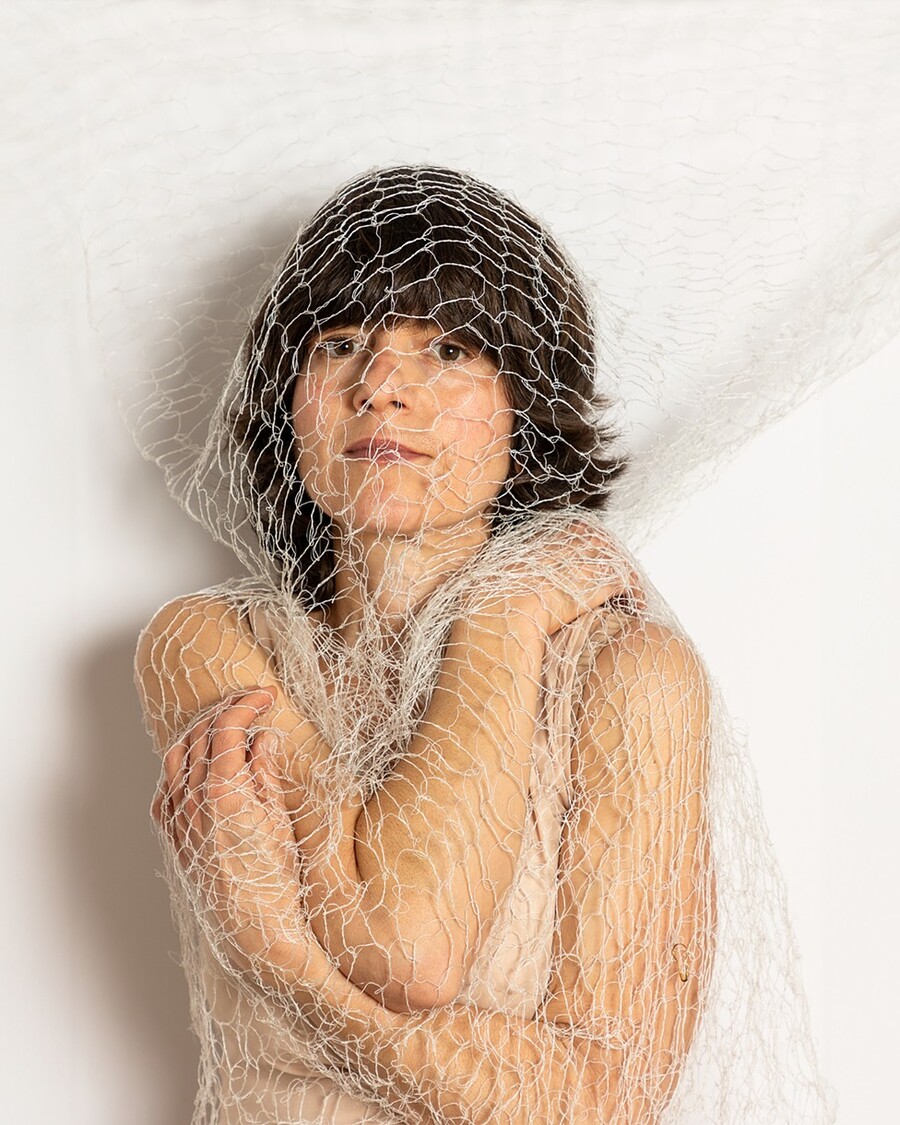
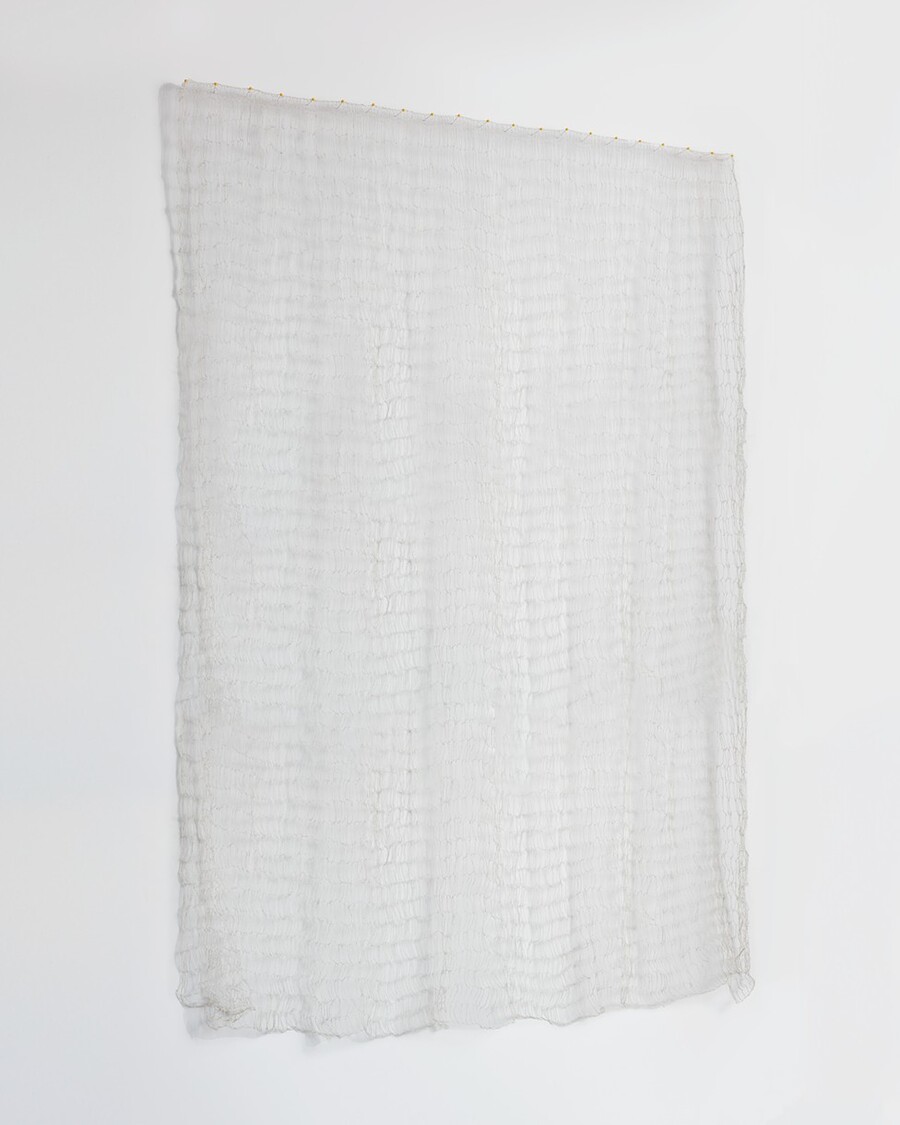
in/visibilityMonofilament, silk, and stainless steel threads40» x 60» x 6"2024
My installations featuring threads are all knit by hand, often over 40,000 stitches, designed from models and diagrams and spreadsheets and many calculations. Ombré color shifts in these hand knit structures are created through combining threads of copper, stainless steel, silk, linen, and bamboo. These sculptural installations always relate to the settings they’re in—scaling up as spaces grow in size, and adapting materials to compliment their environments.
While my public art sculptures feature materials that extend from fiber to metal, and my kinetic sculptures incorporate rope, the core meaning and focus of my artwork remains on the theme of connection.
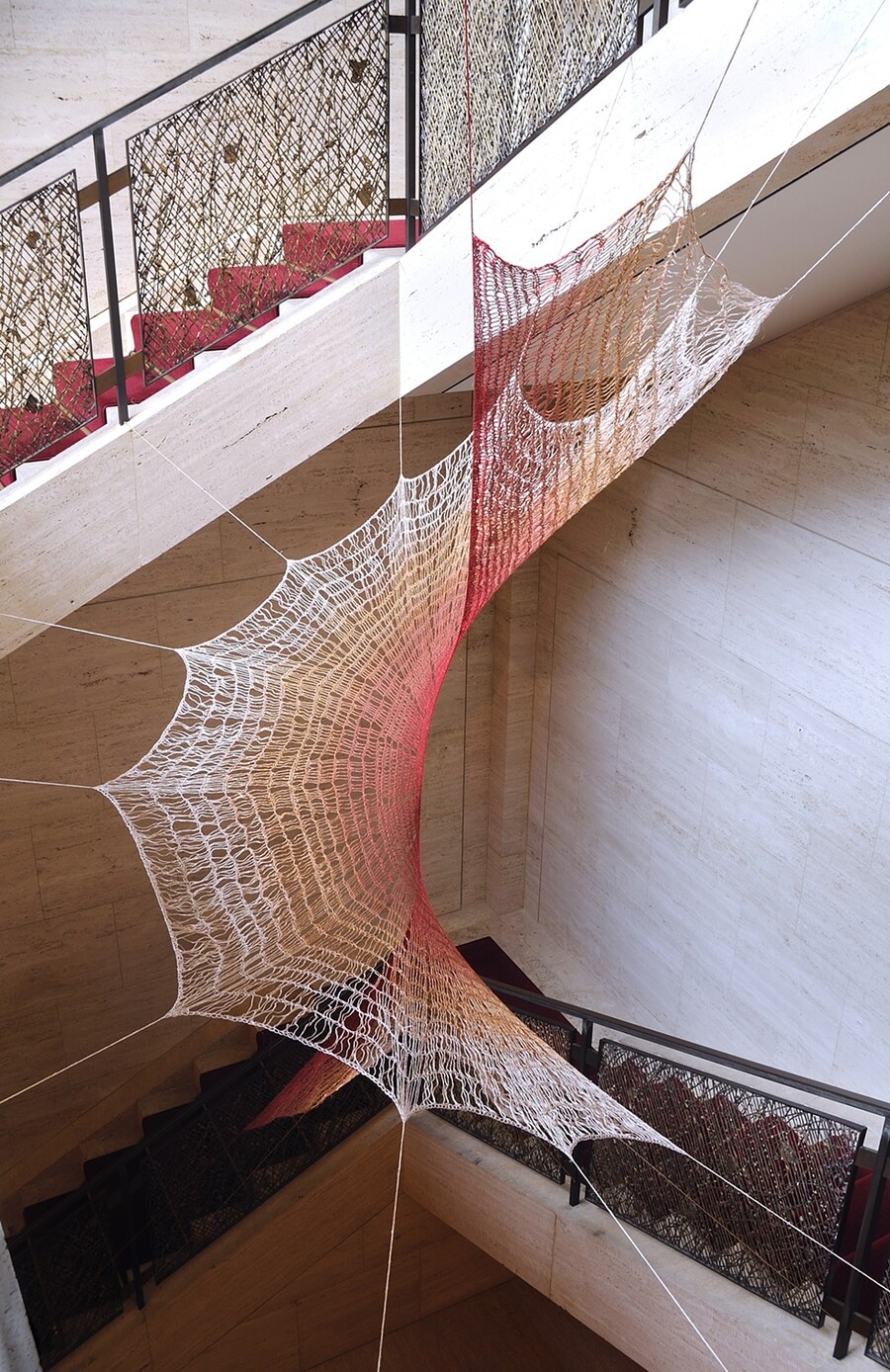
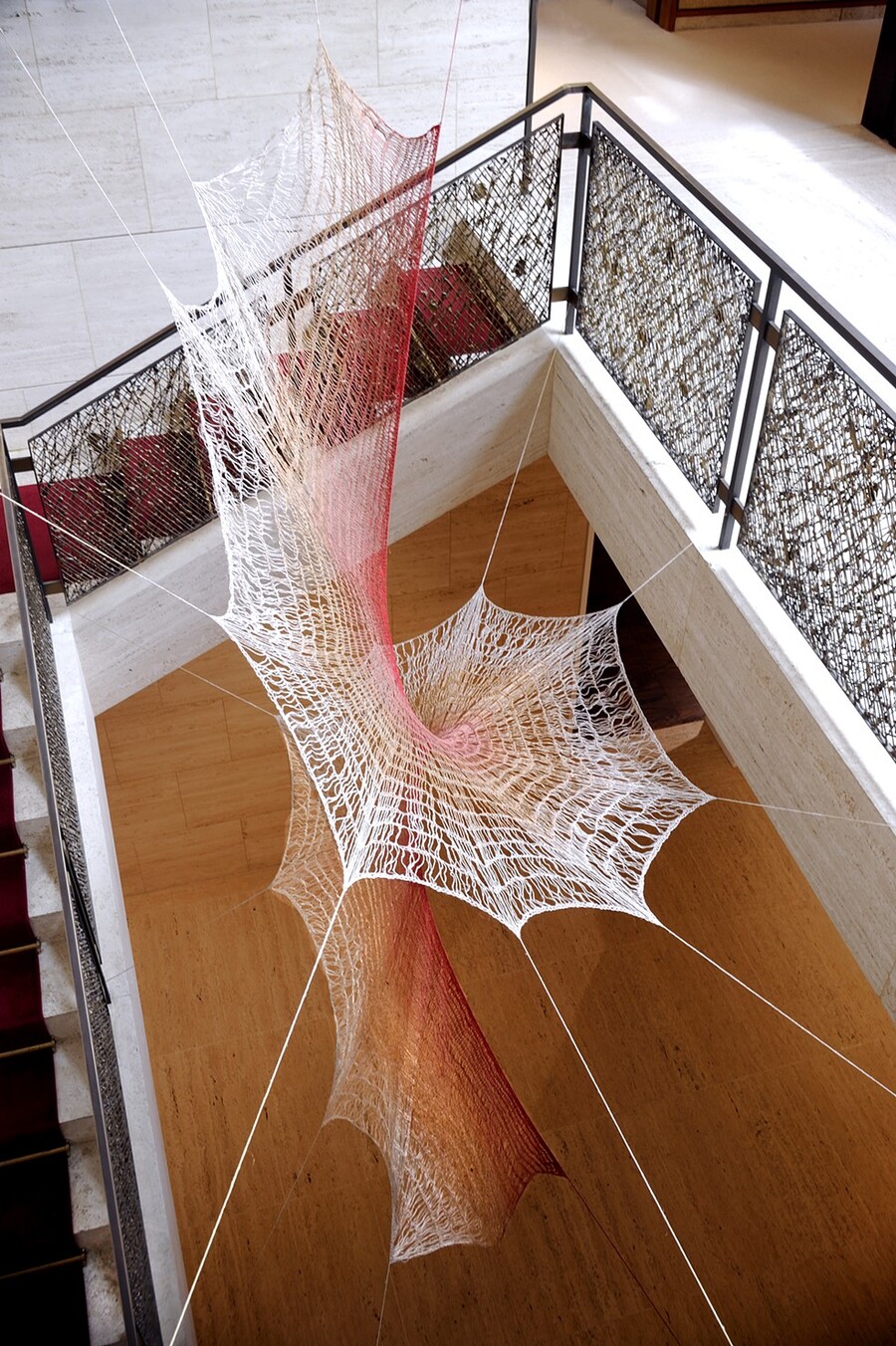
Liminality: Kreeger MuseumSuspended installation: Silk, linen, bamboo, copper, and stainless steel threads2020
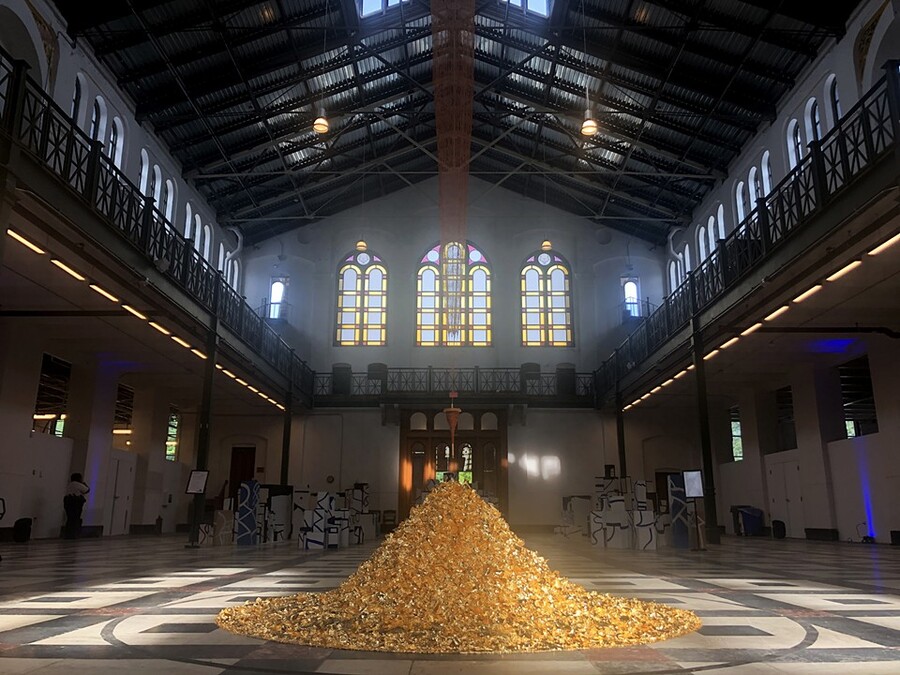
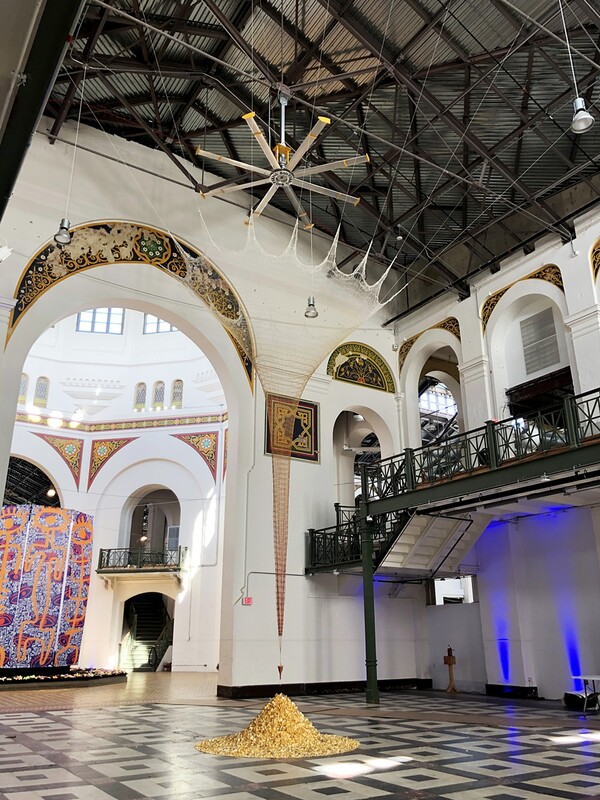
Paths VII: Smithsonian Arts and Industries BuildingSilk, linen, bamboo, copper, stainless steel, wood, and gold2019
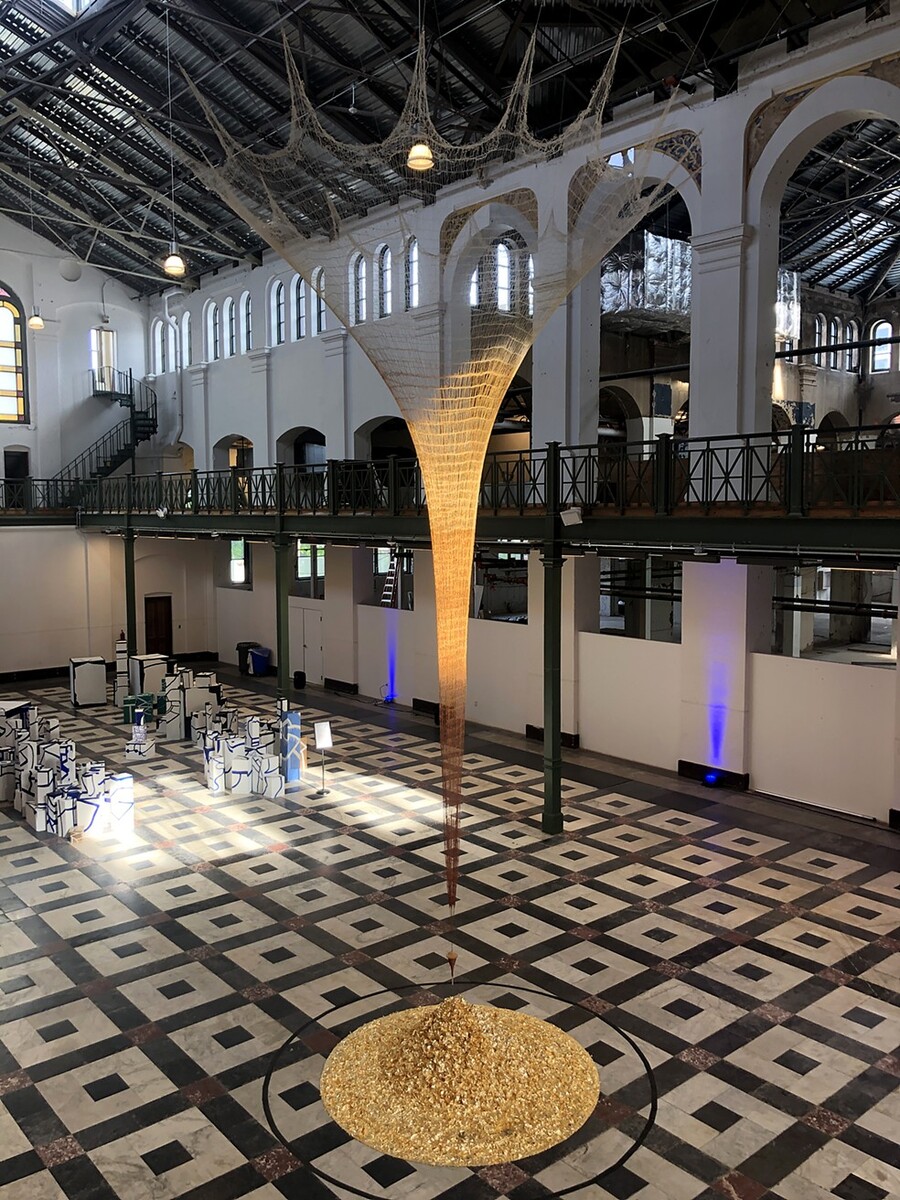
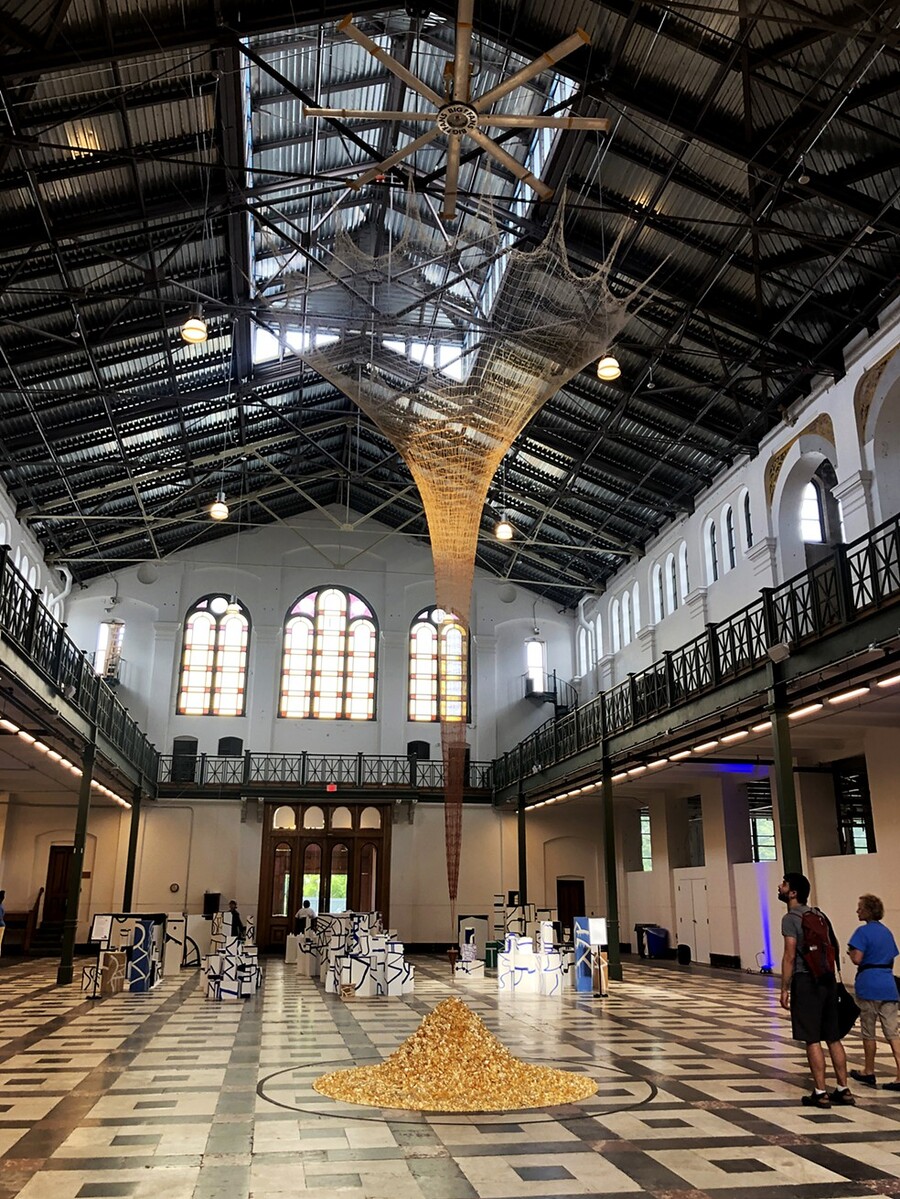
Paths VII: Smithsonian Arts and Industries BuildingSilk, linen, bamboo, copper, stainless steel, wood, and gold2020
Rania Hassan creates site-specific installations that weave sculptural stories about our connections to time, place, and circumstance. The five main themes she works with embody ideas of community, synchronicity, identity, time, and memory. Her work ranges in scale from modular arrangements of 3×4 inch drawings to 40×40×40 foot suspended installations, and materials vary from delicate combinations of the finest threads to plasma cut sheets of rolled steel. Recent projects include Liminality at the Kreeger Museum, a hand knit suspended installation activating the museum’s three level stairwell for the very first time. Marker, a 15 foot tall bright pink sculpture made of steel, has been on view at the highly visible intersection of Connecticut Ave and K Street NW in downtown Washington
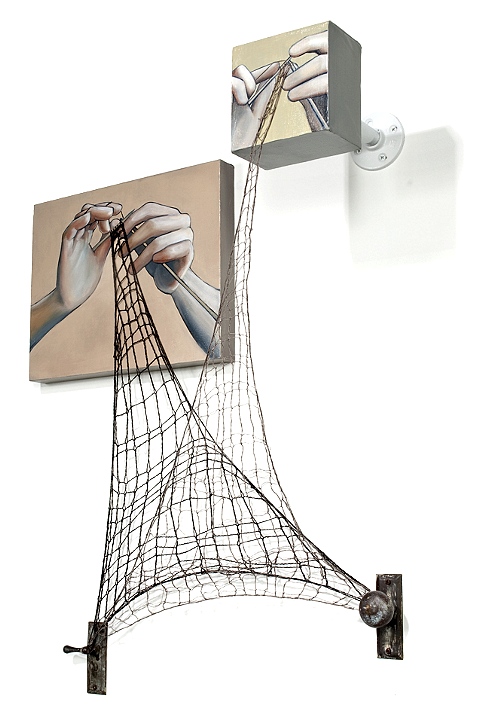
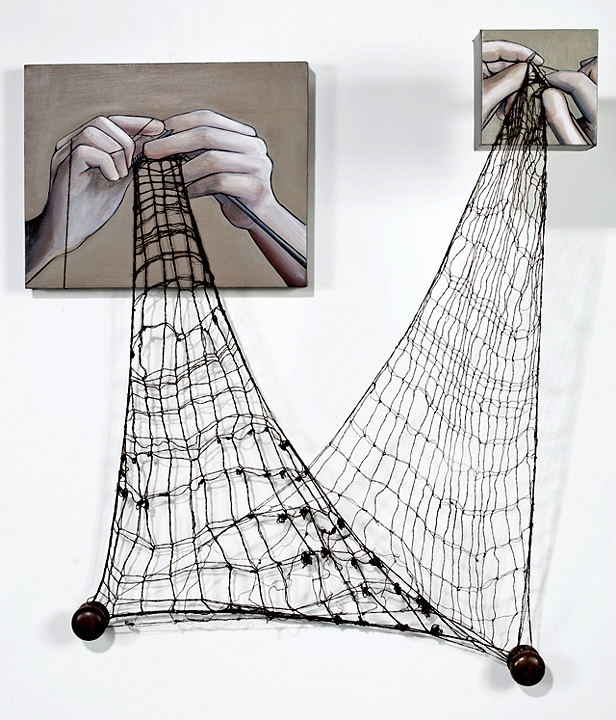
Anchored IOil, Fiber, Canvas, Metal2009
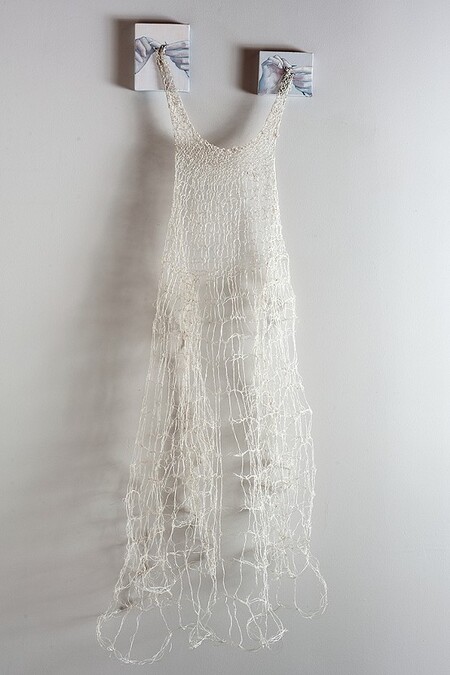
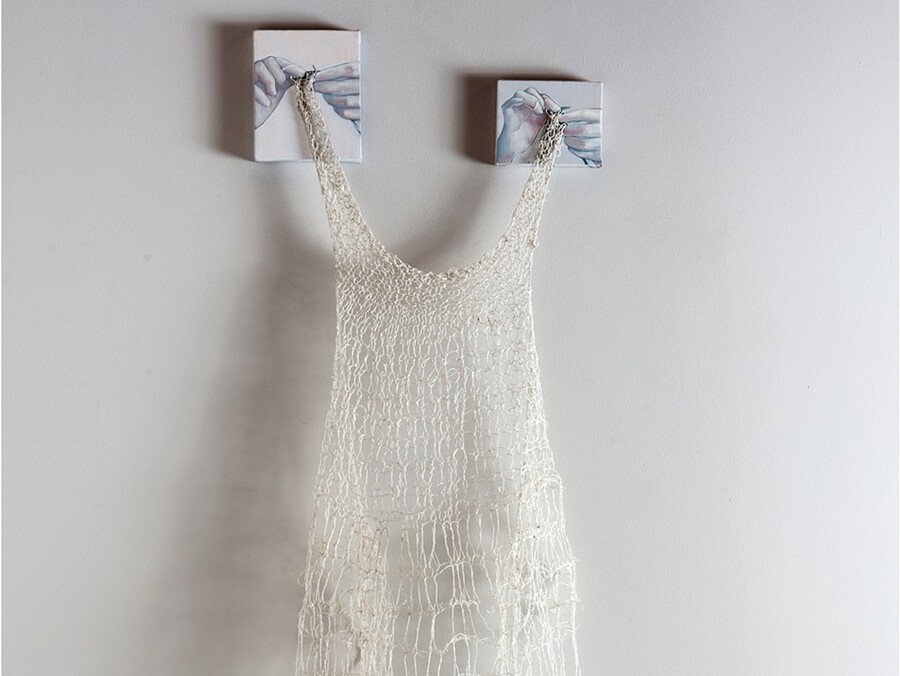
ExpectationsOil, Fiber, Canvas24» x 58» x 12”2013
Tangle IIIOil, Fiber, Wood2020
TangleOil, Fiber, Wood2017
Knit Circle IIOil, Fiber, Canvas, Metal2013
7. Saloua Raouda Choukair (Lebanon) A pioneering Lebanese artist known for her abstract paintings and sculptures. Example: Her work often incorporates geometric shapes and natural materials
Harald Kröner K1965
Years ago on a visit to Beirut, Dia Art Foundation Director and former Tate Modern curator Jessica Morgan saw some work in a gallery by an artist she did not recognize. She inquired about it and was informed it was by a Lebanese artist named Saloua Raouda Choucair. After learning the artist was still active in her studio, Morgan paid Choucair a visit. Upon arriving she was shocked to behold what seemed to be an entire lifetime worth of paintings, sculptures, jewelry and tapestries. Choucair had been working diligently for more than half a century in almost total isolation.
Margaret Neill Dovetail 1
DRAWINGYEAR: 2023EDITION: UNIQUETECHNIQUE: CHARCOAL ON PAPERSIZE: 127 X 96.5
Ludovic Dervillez Chicken Man
PAINTINGYEAR: 2023EDITION: UNIQUETECHNIQUE: MIXED MEDIA ON CANVASSIZE: 130 X 97X 0.1
Martin Reyna Untitled 22033
PAINTINGYEAR: 2022EDITION: UNIQUETECHNIQUE: OIL ON CANVASSIZE: 70 X 49,5X 0.1
Geometric Duality Saloua Raouda Choucair was born in Beirut in 1916, and began painting at the age of 19. She initially began as a figurative artist, painting brightly colored images of daily life that demonstrated an urge toward modernist realism. But after touring the streets of Cairo once, she became enthralled by the language of forms used in the Islamic art and architecture she saw, and for the first time felt compelled to explore abstraction. In an interview for a film accompanying her Tate exhibition, Choucair said, «All the rules that I apply are from the Islamic religion and from Islamic geometric design.
Saloua Raouda Choucair — two pieces from the Dual series, 1978-80, © Saloua Raouda Choucair Foundation
Saloua Raouda Choucair — Dual, 1975-1977, Fiberglass, CRG Gallery, New York, © Saloua Raouda Choucair Foundation
Saloua Raouda Choucair, Poem Cube, 1963-65, Tate Museum
Saloua Raouda Choucair, Poem of Nine Verses, 1966-68, Tate Museum
These artists represent a diverse range of styles, themes, and mediums, showcasing the vibrant and dynamic contemporary art scene in the Middle East and North Africa.
